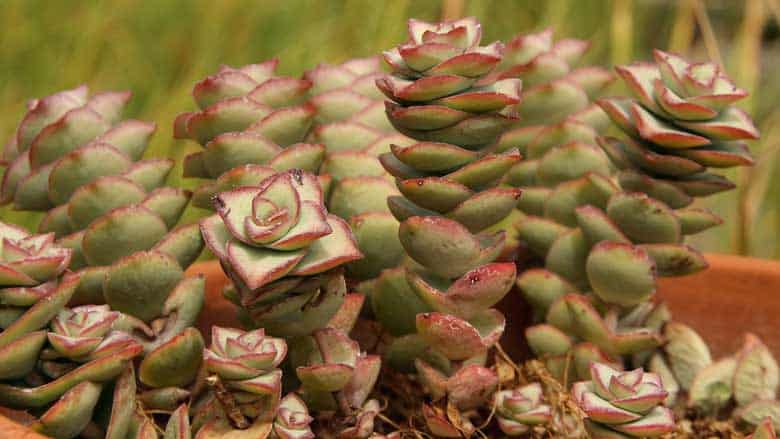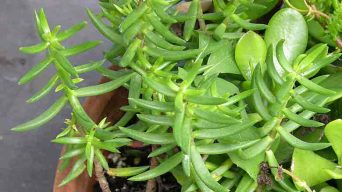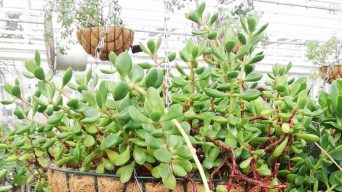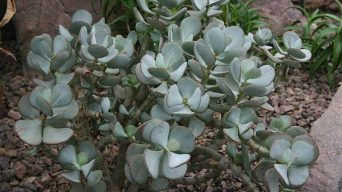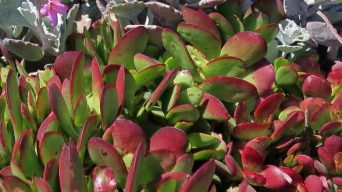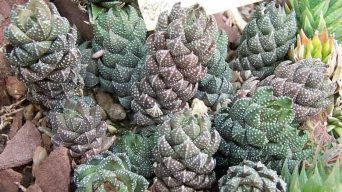The Crassula Rupestris is a succulent plant that grows in the wilds of South Africa.
These plants are easy to care for and propagate, making them ideal additions to any garden or home.
They can be propagated by leaf cuttings, stem cuttings, and even from seed!
This article will cover how to take care of your Crassula Rupestris and how to get more plants so that you never have to worry about running out again.
About Crassula Rupestris (Baby’s Necklace Vine)
The Crassula Rupestris, or Baby’s Necklace Vine, can be found in dry regions of Africa, including Portuguese Guinea, Angola, Namibia, Botswana, the Northern Cape Province in South Africa, and Zimbabwe.
This succulent plant is often seen as a ground cover for dry regions. Still, it can also be planted on top of rocks or walls to bring color to an otherwise barren landscape.
The Crassula rupestris only grows up to one foot tall. It doesn’t have many predators, and animals don’t eat them because they are very tough and contain little nutrients. This makes them great houseplants!
Common names of the Crassula Rupestris include:
- Baby’s Necklace Vine
- Rosary Vine
- Concertina plant
- Rosary Plant
The Crassula Rupestris plant has a small, cylindrical stem that grows from the ground.
They have tight clusters of flowers that can be cream-colored or greenish and are often hidden in the leaves because they form on short stems only about an inch above the soil.
It has been grown outside of its native habitat due to being cultivated for ornamental purposes and just because people enjoy how easy these small succulents are to care for.
How To Care for Crassula Rupestris (Baby’s Necklace Vine)
Sun Exposure & Light Requirements
Crassula Rupestris thrives in a full sun environment and can withstand the harshest conditions. It is also able to tolerate partial shade, but this succulent will grow faster with more sunlight exposure.
It needs at least six hours of direct sunlight per day or five hours with some indirect morning/evening sun to maintain its vivid green foliage color and compact growth pattern.
If you have a south-facing window, this is the perfect spot for your Crassula rupestris plants. With the extra light and heat from the sun, they will grow faster than if they were in less intense sunlight or shade elsewhere.
The protective glass of windows lets more heat into their surroundings, which may also help them thrive indoors when other conditions are right.
If you have a Crassula Rupestris that is doing poorly in its current environment, try moving it to another location and see if the sun exposure is better.
Watering Requirements
Known to be a drought-resistant succulent, the Crassula Rupestris can thrive in containers with infrequent watering.
The plant does not need water more than once every ten days or so and should never be left sitting in stagnant water.
To grow Crassula Rupestris indoors, you need to plant it in soil with good drainage and water it regularly but not too often. You can do this no matter where you live.
In general, Crassula Rupestris is a plant that can be expected to survive for long periods without water or little water.
Soil Requirements
The Crassula Rupestris prefers soil draining well because it is prone to root rot in overly wet environments.
A good mix would consist of roughly 50% potting soil and 50% sand.
Sand provides necessary drainage while still holding enough moisture to help these thirsty plants survive periods without rain during prolonged summer droughts.
An excellent way to check if the soil is draining well enough would be by putting a piece of wet newspaper on top and then checking back after an hour or so.
If most of the paper has dried out, your potting mix may need more sand added to provide adequate drainage for these plants.
Temperature and Humidity Requirements
The Crassula Rupestris plant is quite hardy and can grow in a wide range of climates. However, it does require the right temperature to thrive.
When it comes to temperature requirements for this succulent, they should be between 59 °F (15 °C) and 78° F (25 °C).
The Crassula rupestris also requires less than 50% humidity to thrive and not rot or mold from the inside out.
Fertilizing Crassula Rupestris
The Crassula Rupestris is a succulent plant that needs more frequent fertilization than other plants.
In keeping with the typical rule of thumb, use once-a-month fertilizing in the winter and twice-monthly fertilizers during warmer months.
The best time to add nutrients is when watering your Crassula rupestris or any other succulents for that matter; water runs through the soil carrying dissolved nutrients along with it.
If you want to add fertility, mix liquid houseplant food into a gallon of water and spray onto all surfaces until thoroughly wetted before applying as above.
Instructions on how much fertilizer to apply will depend on what kind of potting soil you use.
Potting and Repotting
When considering a pot for a Crassula Rupestris, the best option is a shallow container. A pot with drainage holes will be essential as this plant does not like sitting in water for too long. The size of the pot depends on how much soil you use.
For example, if there is a dry season, like in wintertime, give it less dirt so that water does not accumulate too quickly and kills the plant.
You will want to make sure there are drainage holes in your container, or else this succulent could drown!
The Crassula likes being watered from above as well as below. This would be a great time to mist them with tepid water using an atomizer bottle every day or two while they’re out of the sun.
The soil should consist of half organic peat and half coarse sand. This mixture provides excellent drainage, prolonging your succulent plants’ life.
A plant that has been in its pot too long can become root bound, meaning its roots are circling around on themselves because they have run out of room.
Putting a plant in a pot that is too small will stunt growth or even kill the plant. The roots will grow inward towards the water because there is no room for them to grow outwards.
Eventually, you may need to use a saw to break through the hard outer bark so more roots can get access to fresh air. Leave enough space for them so they can be healthy.
The best time for this operation is during spring or summer but before fall.
Remove the plant from the pot. Pull apart any roots that are circling on themselves. Cut through the outer bark with a sharp saw to create access for new roots to grow outward again.
Be careful not to damage or pull out too many roots when you transplant a Crassula Rupestris. Root tips are essential for the plant, so try not to cut off too many of them. Plant it in fresh soil, and the root tips will grow back over time.
Pruning
Old leaves should be removed from the Crassula Rupestris (Baby’s Necklace Vine) to stimulate new growth and prevent rot.
Cut off by pulling up on a leaf or with sharp pruning shears. It is better to cut leaves’ stem first so they don’t bleed often. This means you can hold them longer without covering your hands in sap.
New leaves will grow from the center of the rosette. Keep trimming to keep your Crassula Rupestris (Baby’s Necklace Vine) looking tidy and well-groomed, but don’t cut too many, or you’ll end up with a leggy plant!
Pests and Diseases
The Crassula Rupestris is an easy to care for plant, with few pests or diseases.
It grows slowly in the wild, so it’s a good choice if you want something that requires less work.
Common Pests
However, there are some insects they can be affected by:
- Spider mites
- Mealybugs
- Scale insects
These bugs will suck the sap from the leaves until they drop off dry and shriveled after being infested with these bugs for too long.
To prevent this problem, mix insecticidal soap solution with water and spray your soil every two weeks.
Common Diseases
Common diseases that can affect the Crassula Rupestris are:
- Botrytis cinerea
- Septoria leaf spot
These diseases will cause the plant to rot and fall apart. To help prevent this problem:
- Use copper fungicide around your Crassula Rupestris plants every few weeks during the growing season (spring through summer).
- If you notice any symptoms of a disease on your Crassula Rupestris, remove affected leaves as soon as possible so that it doesn’t spread too quickly or get worse.
- Spray with the hydrogen peroxide solution and water to control spreading further damage.
How To Propagate Crassula Rupestris’ Baby’s Necklace Vine’
Leaves, stem cuttings, and seeds can propagate the Crassula Rupestris.
Leaf Cutting
Smaller plants can be propagated from leaf cuttings.
Cut a healthy, thick leaf off the plant and let it callous over for two days before planting in potting soil or another well-draining medium.
Place this cutting in a sunny location to promote the growth of roots on the undersides of leaves. Water regularly until new growth appears.
Watch out for any signs of rot or decay, which may signal that your cutting needs more time to root correctly.
Stem Cuttings
If you want to grow a larger Crassula Rupestris succulent, take cuttings from it.
A cutting should have a branch that is at least three inches long with several nodes along its length. Cut the stem into three-inch long pieces using a sharp, clean blade.
- Cut off all leaves from the end of each branch (the bottom). To create a new plant, you will need at least one node with two sets of leaves on it that is about an eighth inch in diameter.
- Place your cutting inside a cylindrical container filled with well-drained soil mix and mist for several days until sprouts appear.
- Once they have grown four inches tall, transfer them into their pots so they can grow larger together before planting them outside or giving them as gifts. If you want to grow succulents from cuttings, it might help if you put some rooting hormone on the ends of the branches where you cut.
- When plants are in their new pot, cut off leaves that touch the soil. Trim a few inches off the stem. This will make the plant strong when you take it outside or give it away as a gift.
Troubleshooting: If your succulent does not start growing within two weeks after planting, take it back inside where there’s more light for another week before trying again.
Seeds
Crassula Rupestris seeds should be sown in late winter or early spring.
When it comes to soil, you can use a cactus mix (i.e., 50% pumice and 50% perlite). If this is not available, then potting up the seedlings into individual containers using any good quality potting mixture for succulents would do.
You will need a sterile container with drainage holes. It should also be deep enough to accommodate the length of your plant’s stem without burying any leaves under too much growing medium.
Simply fill the container with potting mixture, push your seeds into it, and then cover them lightly.
It is important not to put plants in saucers of wet soil until their roots are established enough to prevent root rot. Overwatering is a major cause of plant death, so be careful.
It is also best if the plants are placed in half-shade or bright indirect light to prevent them from frying out and becoming “leggy.
Is the Crassula Rupestris Toxic?
Crassula Rupestris is not toxic to humans, dogs, or other common pets. It is safe to be eaten by pets.
A common misconception about this plant is that it contains thorns. Still, they are non-existent in the Crassula Rupestris species.
The leaves themselves can cause irritation if someone comes into contact with them for extended periods or during sensitive times such as sunburns and open wounds.
It does not typically produce any latex from its stems or branches, which would make it poisonous like other plants do (such as rubber trees).
Final Thoughts
The Crassula Rupestris is a very easy plant to care for and propagate.
It is a succulent plant that can be grown indoors or outdoors.
It is a very low-maintenance plant, and it will grow well in any type of pot. It needs very little water and will thrive in the right environment, making it an ideal houseplant for any type of indoor dwelling.

